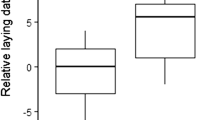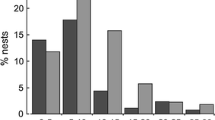Abstract
The Lanyu Scops Owl (Otus elegans) breeds in natural tree cavities on Lanyu (Orchid Island), a subtropical island off the southeastern coast of Taiwan in the western Pacific. There are no cavity-making birds or mammals on the island. This study attempted to understand the relationship between this owl’s cavity use and breeding success. In a 10-ha study site, all cavities on all trees with a diameter breast height larger than 18 cm were documented. There were 257 cavities in 119 trees, and 94 of them were used by owls at least once during the study period. The detailed location and size of these 94 cavities in 74 trees were recorded and monitored. From 1999 to 2006, more than 80% of breeding owls were color-marked and their cavity use and breeding success were tracked. Nest trees were taller than other trees, and cavities used by owls were higher above the ground, and larger than unused cavities. Unused cavities were mostly unsuitable due to flooding or decay, or were on trees already containing a nest. Regardless of how many cavities there were on a tree, a single tree never had more than one Lanyu Scops Owl nest at a given time. More than 60% of the 94 cavities were used multiple times. Cavity occupancy frequently showed gaps, usually following breeding failure. Cavity quality (the proportion of years a cavity was used during the study) and female quality (the proportion of years an owl bred out of the total number of years it competed for cavities) significantly contributed to the average fledging success of owls, but male quality did not.


Similar content being viewed by others
References
Aitken KEH, Martin K (2004) Nest cavity availability and selection in aspen-conifer groves in a grassland landscape. Can J For Res 34:2099–2109
Aitken KEH, Martin K (2007) Plasticity in resource selection affects community responses to an experimental reduction in availability of a critical resource. Ecology (in press)
Albano DJ (1992) Nesting mortality of Carolina Chickadees breeding in natural cavities. Condor 94:371–382
Belthoff JR, Ritchison G (1990) Nest-site selection by Eastern Screech-Owls in central Kentucky. Condor 92:982–990
Bock CE, Cruz A Jr, Grant MC, Aid CS, Strong TR (1992) Field experimental evidence for diffuse competition among southwestern riparian birds. Am Nat 140:815–828
Bock CE, Fleck DC (1995) Avian response to nest box addition in two forests of the Colorado Front Range. J Field Ornithol 66:352–362
Brush T (1983) Cavity use by secondary cavity-nesting birds and response to manipulations. Condor 85:461–466
Bull EL, Parks CG, Torgersen TR (1997) Trees and logs important to wildlife in the interior Columbia River basin. Gen. Tech. Rep. PNW-GTR-391. US Dept. of Agriculture, Forest Service, Pacific Northwest Research Station, Portland, OR, 55 p
Bunnell FL, Wind E, Boyland M, Houde I (2002) Diameters and heights of trees with cavities: their implications to management. USDA Forest Service. Gen. Tech. Rep. PSW-GTR-181. 717–737
Calson A, Sandstrom U, Olsson K (1998) Availability and use of natural tree holes by cavity nesting birds in a Swedish deciduous forest. Ardea 86:109–119
Cameron M (2006) Nesting habitat of the glossy black-cockatoo in central New South Wales. Biol Conserv 127:402–410
Eason PK, Stamps JA (1992) The effect of visibility on territory size and shape. Behav Ecol 3:166–172
Forsman ED, Giese AR (1997) Nests of Northern Spotted Owls on the Olympic Peninsula, Washington. Wilson Bull 109:28–41
Holt RF, Martin K (1997) Landscape modification and patch selection: the demography of two secondary cavity nesters colonizing clearcuts. Auk 114:443–455
Hsu YC, Li SH, Lin YS, Philippart MT, Severinghaus LL (2006a) High frequency of extra-pair copulation with low level of extra-pair fertilization in the Lanyu Scops Owl (Otus elegans botelensis). J Avian Biol 37:36–40
Hsu YC, Li SH, Lin YS, Severinghaus LL (2006b) Microsatellite loci from Lanyu Scops Owl (Otus elegans botelensis) and their cross-species application in four species of Strigidae. Conserv Genet 7:161–165
Hsu YC, Severinghaus LL, Lin YS, Li SH (2003) Isolation and characterization of microsatellite DNA markers from the Lanyu Scops Owl (Otus elegans botelensis). Mol Ecol Notes 3:595–597
Ingold DJ (1989) Nesting phenology and competition for nestsites among Red-headed and Red-bellied Woodpeckers and European Starlings. Auk 106:209–217
Jackson JA, Jackson BJS (2004) Ecological relationships between fungi and woodpecker cavity sites. Condor 106:37–49
Lee YF, Severinghaus LL (2004) Sexual and seasonal differences in the diet of Lanyu Scops Owls. J Wildl Manage 68:290–297
Li P, Martin TE (1991) Nest-site selection and nesting success of cavity-nesting birds in high elevation forest drainages. Auk 108:405–418
Loeb SC, Hooper RG (1997) An experimental test of interspecific competition for Red-cockaded Woodpecker cavities. J Wildl Manage 61:1268–1280
Lohmus A (2003) Do Ural Owls (Strix uralensis) suffer from the lack of nest sites in managed forests? Biol Conserv 110:1–9
McCallum DA, Gehlbach FR (1988) Nest-site preferences of Flammulated Owls in western New Mexico. Condor 90:653–661
McCelland RB (1977) Relationships between hole-nesting birds, forest snags, and decay in western larch-Douglas-fir forests of the northern Rocky Mountains. Missoula, MT: University of Montana. 483 p. Ph.D. dissertation. Cited in Steeger C, Dulisse J (2002) Characteristics and dynamics of cavity nest trees in southern British Columbia. Gen. Tech. Rep. PSW-GTR-181. USDA Forest Service, Albany, California.
Gutzwiller KJ, Anderson SH (1987) Multiscale associations between cavity-nesting birds and features of Wyoming streamside woodlands. Condor 89:534–548
Mohan CL, Martin K, Seventon JD (2007) Habitat attributes and chestnut-backed chikadee nest site selection in uncut and partial-cut forests. Can J For Res 37:1272–1285
Newton I (1994) The role of nest sites in limiting the numbers of hole-nesting birds: a review. Biol Conserv 70:265–276
Radford AN, Du Plessis MA (2003) The importance of rainfall to a cavity-nesting species. Ibis 145:692–694
Schepps J, Lohr S, Martin TE (1999) Does tree hardness influence nest-tree selection by primary cavity nesters? Auk 116:658–665
Sedgwick JA (1997) Sequential cavity use in a cottonwood bottomland. Condor 99:880–887
Sedgwick JA, Knopf FL (1986) Cavity-nesting birds and the cavity-tree resource in plains cottonwood bottomlands. J Wildl Manage 50:247–252
Sedgwick JA, Knopf FL (1990) Habitat relationships and nest site characteristics of cavity-nesting birds in cottonwood floodplains. J Wildl Manage 54:112–124
Sedgwick JA, Knopf FL (1992) Cavity turnover and equilibrium cavity densities in a cottonwood bottomland. J Wildl Manage 56:477–484
Severinghaus LL (1986) An ecological study of Lanyu Scops Owls (Otus elegans botelensis). No. 15. Council of Agriculture, Executive Yuan, Taipei, Taiwan (in Chinese)
Severinghaus LL (1987) An ecological study of Lanyu Scops Owls (Otus elegans botelensis) and its management. No. 16. Council of Agriculture, Executive Yuan, Taipei, Taiwan (in Chinese)
Severinghaus LL (1988) Ecology and management of Lanyu Scops Owls (Otus elegans botelensis). No. 22. Council of Agriculture, Executive Yuan, Taipei, Taiwan (in Chinese)
Severinghaus LL (1989a) Ecology and management of Lanyu Scops Owls (Otus elegans botelensis)-IV. No. 17. Council of Agriculture, Executive Yuan, Taipei, Taiwan (in Chinese)
Severinghaus LL (1989b) The status and conservation of Lanyu Scops Owl (Otus elegans botelensis). In: Meyburg BU, Chancellor RD (eds) Raptors in the modern world. World Working Group of Birds of Prey and Owls, London, pp 423–432
Severinghaus LL (1990) Ecology and conservation of Lanyu Scops Owls (Otus elegans botelensis). No. 31. Council of Agriculture, Executive Yuan, Taipei, Taiwan (in Chinese)
Severinghaus LL (1991) Social behavior and habitat use of Lanyu Scops Owls (Otus elegans botelensis). No. 21. Council of Agriculture, Executive Yuan, Taipei, Taiwan (in Chinese)
Severinghaus LL (1992) Monitoring the population of the endangered Lanyu Scops Owl (Otus elegans botelensis). In: McCullough DR, Barrett RH (eds) Wildlife 2001: populations. Elsevier, London, pp 790–802
Severinghaus LL (2000) Territoriality and the significance of calling in the Lanyu Scops Owl. Ibis 142:297–304
Severinghaus LL (2002) Home-range, movement and dispersal of Lanyu Scops Owls (Otus elegans). In: Newton I, Kavanagh RP, Olsen J, Taylor IR (eds) Ecology and conservation of owls. CSIRO Publishing, Melbourne, pp. 58–67
Severinghaus LL, Rothery P (2001) The survival rate of Lanyu Scops Owl. Ibis 143:540–546
Siikamäki P (1996) Nestling growth and mortality of Pied Flycatchers Ficedula hypoleuca in relation to weather and breeding effort. Ibis 138:471–478
Sonerud GA (1985) Risk of nest predation in three species of hole nesting owls: influence on choice of nesting habitat and incubation behaviour. Ornis Scand 16:261–269
Steeger C, Dulisse J (2002) Characteristics and dynamics of cavity nest trees in southern British Columbia. USDA Forest Service Gen. Tech. Rep. PSW-GTR-181, USDA Forest Service, Albany, California, pp 275–289
Wang WM (2004) The impact of vegetation by the Yami in Lanyu. Ms. thesis. Tainan Normal College, Tainan, Taiwan
Waters JR, Noon BR, Verner J (1990) Lack of nest site limitation in a cavity-nesting birds community. J Wildl Manage 54:239–245
Wesołowski T (1995) The loss of avian cavities by injury compartmentalization in a primeval European forest. Condor 97:256–257
Wiebe KL (2001) Microclimate of tree cavity nests: is it important for reproductive success in Northern Flickers? Auk 118:412–421
Yetter AP, Havera SP, Hine CS (1999) Natural-cavity use by nesting Wood Ducks in Illinois. J Wildl Manage 63:630–638
Zarnowitz JE, Manuwal DA (1985) The effects of forest management on cavity-nesting birds in northwestern Washington. J Wildl Manage 49:255–263
Acknowledgments
This study was supported by grants from the National Science Council of Taiwan and the Research Center for Biodiversity, Academia Sinica, Taiwan. Chien-hung Yang, Mark Philippart, Jerome Chien, I-hua Lin, Chien-wei Kuan, Shih-cheng Huang, Wen-chun Li, and Chin-kuo Lee climbed trees numerous times to measure cavities and helped with field work in general. Chin-Kuo Lee, Shih-fan Chan, Wen-yin Hu and Dr. Ming-chih Wang helped with data analyses. Ms. Shu-chun Chen and Dr. Pi-chiang Li kindly gave advice on data analysis. Dr. Cheng-heng Hu assisted in the identification of the ants. Two reviewers provided valuable comments that greatly improved the manuscript. To all of them, I wish to express my deepest gratitude. All work done related to this study complied with the laws of Taiwan.
Author information
Authors and Affiliations
Corresponding author
Additional information
Communicated by F. Bairlein.
Rights and permissions
About this article
Cite this article
Severinghaus, L.L. Cavity dynamics and breeding success of the Lanyu Scops Owl (Otus elegans). J Ornithol 148 (Suppl 2), 407–416 (2007). https://doi.org/10.1007/s10336-007-0249-7
Received:
Revised:
Accepted:
Published:
Issue Date:
DOI: https://doi.org/10.1007/s10336-007-0249-7




